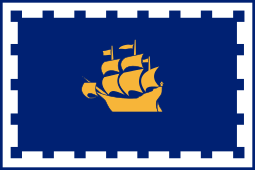James Wolfe
| General James Wolfe | |
|---|---|
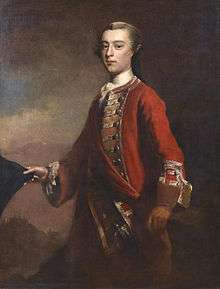 "Major General Wolfe. Who, at the Expence of his Life, purchas'd immortal Honour for his Country, and planted,with his own Hand, the British Laurel, in the inhospitable Wilds of North America, By the Reduction of Quebec, Septr. 13th. 1759." | |
| Born |
2 January 1727 Westerham, Kent, England |
| Died |
13 September 1759 (aged 32) Quebec, New France |
| Buried at | St Alfege Church, Greenwich |
| Allegiance |
|
| Service/branch |
|
| Years of service | 1740–13 September 1759 † |
| Rank | Major General |
| Commands held | 20th Regiment of Foot |
| Battles/wars | |
| Relations | Lieutenant General Edward Wolfe (father) |
| Signature |
|
Major General James Wolfe (2 January 1727 – 13 September 1759) was a British Army officer, known for his training reforms but remembered chiefly for his victory over the French at the Battle of the Plains of Abraham in Canada in 1759. The son of a distinguished general, Edward Wolfe, he had received his first commission at a young age and saw extensive service in Europe where he fought during the War of the Austrian Succession. His service in Flanders and in Scotland, where he took part in the suppression of the Jacobite Rebellion, brought him to the attention of his superiors. The advancement of his career was halted by the Peace Treaty of 1748 and he spent much of the next eight years on garrison duty in the Scottish Highlands. Already a brigade major at the age of eighteen, he was a lieutenant-colonel by the age of twenty-three.
The outbreak of the Seven Years' War in 1756 offered Wolfe fresh opportunities for advancement. His part in the aborted raid on Rochefort in 1757 led William Pitt to appoint him second-in-command of an expedition to capture the Fortress of Louisbourg. Following the success of the Siege of Louisbourg he was made commander of a force which sailed up the Saint Lawrence River to capture Quebec City. After a long siege Wolfe defeated a French force under Louis-Joseph de Montcalm allowing British forces to capture the city. Wolfe was killed at the height of the Battle of the Plains of Abraham due to injuries from three musket balls.
Wolfe's part in the taking of Quebec in 1759 earned him posthumous fame, and he became an icon of Britain's victory in the Seven Years War and subsequent territorial expansion. He was depicted in the painting The Death of General Wolfe, which became famous around the world. Wolfe was posthumously dubbed "The Hero of Quebec", "The Conqueror of Quebec", and also "The Conqueror of Canada", since the capture of Quebec led directly to the capture of Montreal, ending French control of the country.
Early life (1727–1740)
James Wolfe was born at the local vicarage on 2 January 1727 (New Style or 22 December 1726 Old Style) at Westerham, Kent, the older of two sons of Colonel (later Lieutenant General) Edward Wolfe,[1] a veteran soldier of Irish origin, and the former Henrietta Thompson. His uncle was Edward Thompson MP, a distinguished politician. His relatively humble birth marked him out from many army officers at the time, who were disproportionately drawn from the aristocracy or gentry.[2] Wolfe's childhood home in Westerham, known in his lifetime as Spiers, has been preserved in his memory by the National Trust under the name Quebec House.[3] Wolfe's family were long settled in Ireland and he regularly corresponded with his uncle Major Walter Wolfe in Dublin; Stephen Woulfe, the distinguished Irish politician and judge of the next century, was from the Limerick branch of the same family.
The Wolfes were close to the Warde family, who lived at Squerryes Court in Westerham. Wolfe's boyhood friend George Warde would later achieve fame as Commander-in-Chief in Ireland when he crushed the Irish rebellion of 1798, and repelled two attempted French invasions in 1796 and 1798.
Around 1738, the family moved to Greenwich, in London. From his earliest years, Wolfe was destined for a military career, entering his father's 1st Marine regiment as a volunteer at the age of thirteen.
Illness prevented him from taking part in a large expedition against Spanish-held Cartagena in 1740, and his father sent him home a few months later.[4] He was fortunate to miss what proved to be a disaster for the British forces at the Siege of Cartagena during the War of Jenkins' Ear with most of the expedition dying from disease.[5]
War of the Austrian Succession (1740–1748)
European War
In 1740 the War of the Austrian Succession broke out in Europe. Although initially Britain did not actively intervene, the presence of a sizable French army near the border of the Austrian Netherlands compelled the British to send an expedition to help defend the territory of their Austrian ally in 1742. James Wolfe was given his first commission as a second lieutenant in his father's regiment of Marines in 1741. Early in the following year he transferred to the 12th Regiment of Foot, a British Army infantry regiment, and set sail for Flanders some months later where the British took up position in Ghent.[6] Here, Wolfe was promoted to Lieutenant and made adjutant of his battalion. His first year on the continent was a frustrating one as, despite rumours of a British attack on Dunkirk, they remained inactive in Flanders.[7]

In 1743, he was joined by his younger brother, Edward, who had received a commission in the same regiment.[8] That year the Wolfe brothers took part in an offensive launched by the British. Instead of moving southwards as expected, the British and their allies instead thrust eastwards into Southern Germany where they faced a large French army.[9] The army came under the personal command of George II[10] but in June he appeared to have made a catastrophic mistake which left the Allies trapped against the River Main and surrounded by enemy forces in "a mousetrap".[11]
Rather than contemplate surrender, George tried to rectify the situation by launching an attack on the French positions near the village of Dettingen. Wolfe's regiment was involved in heavy fighting, as the two sides exchanged volley after volley of musket fire. His regiment had suffered the highest casualties of any of the British infantry battalions, and Wolfe had his horse shot from underneath him.[12] Despite three French attacks the Allies managed to drive off the enemy, who fled through the village of Dettingen which was then occupied by the Allies. However, George failed to adequately pursue the retreating enemy, allowing them to escape.[13] In spite of this the Allies had successfully thwarted the French move into Germany, safeguarding the independence of Hanover.
Wolfe's regiment at Battle of Dettingen came to the attention of the Duke of Cumberland[14] who had been close to him during the battle when they came under enemy fire. A year later, he became a captain of the 45th Regiment of Foot. After the success of Dettingen, the 1744 campaign was another frustration as the Allies forces now led by George Wade failed to complete their objective of capturing Lille, fought no major battles, and returned to winter quarters at Ghent without anything to show for their efforts. Wolfe was left devastated when his brother Edward died, probably of consumption, that autumn.[15]
Wolfe's regiment was left behind to garrison Ghent, which meant they missed the Allied defeat at the Battle of Fontenoy in May 1745 during which Wolfe's former regiment suffered extremely heavy casualties. Wolfe's regiment was then summoned to reinforce the main Allied army, now under the command of the Duke of Cumberland. Shortly after they had departed Ghent, the town was suddenly attacked by the French who captured it and its garrison.[16] Having narrowly avoided becoming a French prisoner, Wolfe was now made a brigade major.
Jacobite Rising

In January 1746, Wolfe's regiment was urgently recalled to Great Britain to deal with the Jacobite rising which had broken out. In September Jacobite forces had won the Battle of Prestonpans and captured Edinburgh. They were poised to march into England where they expected a mass Jacobite rebellion to break out that would topple George II and his Hanoverian Dynasty and replace them with the Young Pretender, Bonnie Prince Charlie.[17]
Wolfe and his regiment were initially sent to Newcastle to bolster a force commanded by General Wade to prevent a Jacobite advance along the east coast. Instead the rebels bypassed Wade's army at Newcastle, by heading down the opposite coast via Carlisle.[18] The Jacobites reached as far as Derby and only a force of militia stood between them and London. However, having encountered limited English support for their cause the Jacobites decided to withdraw and by the end of the year they were back in France[19] and government forces prepared for what they believed would be a relatively easy campaign that would crush the rebels.
Wolfe served in Scotland in 1746 as aide-de-camp under General Henry Hawley in the campaign to defeat the Jacobite forces of Charles Edward Stuart. In this capacity, Wolfe participated in the Battle of Falkirk and the Battle of Culloden.[20] At Culloden, he famously refused to shoot Charles Fraser, a wounded Highland soldier, when he was ordered by the Duke of Cumberland stating that he would rather resign his post than sacrifice his honour. However, the gesture did work, and the man was shot by Cumberland himself. It has been suggested that it may have been Hawley who gave the order rather than Cumberland.[21] This act may have been a cause for his later popularity among the Royal Highland Fusiliers, whom he would command in North America. After this he took part in the pacification of the Highlands, designed to destroy the remnants of the rebellion.
Return to the Continent
In January 1747 Wolfe returned to the Continent and the War of the Austrian Succession, serving under Sir John Mordaunt. The French had taken advantage of the absence of Cumberland's British troops and had made advances in the Austrian Netherlands including the capture of Brussels.[22][23]
The major French objective in 1747 was to capture Maastricht considered the gateway to the Dutch Republic. Wolfe was part of Cumberland's army, which marched to protect the city from the advancing French force under Marshal Saxe. On 2 July Wolfe participated in the Battle of Lauffeld,he was very badly wounded and received an official commendation for services to Britain. Lauffeld was the largest battle in terms of numbers in which Wolfe fought,[24] with the combined strength of both armies totalling over 140,000. Following their narrow victory at Lauffeld, the French captured Maastricht and seized no more strategic fortress at Bergen-op-Zoom. Both sides remained poised for further offensives, but an armistice halted the fighting.
In 1748, at just 21 years of age and with service in seven campaigns, Wolfe returned to Britain following the Treaty of Aix-la-Chapelle which ended the war. Under the treaty, Britain and France had agreed to exchange all captured territory and the Austrian Netherlands were returned to Austrian control.
Peacetime service (1748–1756)
Scottish garrison
Once home, he was posted to Scotland and garrison duty, and a year later was made a major, in which rank he assumed command of the 20th Regiment, stationed at Stirling. In 1750, Wolfe was confirmed as Lieutenant Colonel of the regiment.
During the eight years Wolfe remained in Scotland, he wrote military pamphlets and became proficient in French, as a result of several trips to Paris. Despite struggling with bouts of ill health suspected to be tuberculosis, he also tried to keep himself mentally fit by teaching himself Latin and mathematics, also Wolfe trained his body too, pushing himself to improve his swordsmanship and attending sessions where he learned about science and how to improve his leadership skills. Wolfe worked hard despite his illness and learned from many people. Wolfe had made the number of influential acquaintances during the recent war. His father, who was now a General, also actively assisted his son's career.
In 1752 Wolfe was granted extended leave, and he first went to Ireland staying in Dublin with his uncle and visiting Belfast and the site of the Battle of the Boyne.[25] After a brief stop at his parents house in Greenwich he received permission from the Duke of Cumberland to go abroad and he crossed the Channel to France. He took in the sights of Paris including the Tuileries Gardens and visited the Palace of Versailles. He was frequently entertained by the British Ambassador, Earl of Albemarle, with whom he had served in Scotland in 1746. Albemarle arranged an audience for Wolfe with Louis XV. While in Paris Wolfe spent money on improving his French and his fencing skills.[26] He applied for further leave so he could witness a major military exercise by the French army, but he was instead urgently ordered home. He rejoined his regiment in Glasgow. By 1754 Britain's declining relationship with France made a fresh war imminent and fighting broke out in North America between the two sides.
Discipline
Desertion, especially in the face of the enemy had always officially been regarded as a capital offence. Wolfe laid particular stress on the importance of the death penalty and in 1755 he ordered that any soldier who broke ranks ("offers to quit his rank or offers to flag") should be instantly put to death by an officer or sergeant.[27]
Seven Years' War (1756–63)

In 1756, with the outbreak of open hostilities with France, Wolfe was promoted to Colonel. He was stationed in Canterbury, where his regiment had been posted to guard his home county of Kent against a French invasion threat. He was extremely dispirited by news of the loss of Minorca in June 1756, lamenting what he saw as the lack of professionalism amongst the British forces. Despite a widespread belief that French landing was imminent, Wolfe thought that it was unlikely his men would be called into action.[28] In spite of this, he trained them diligently and issued fighting instructions to his troops.
As the threat of invasion decreased, the regiment was marched to Wiltshire. Despite the initial setbacks of the war in Europe and North America, the British were now expected to take the offensive and Wolfe anticipated playing a major role in future operations. However, his health was beginning to decline, which led to suspicions that he was suffering, as his younger brother (Edward Wolfe 1728–1744) had, from consumption.[29] Many of his letters to his parents began to assume a slightly fatalistic note in which he talked of the likelihood of an early death.[30]
Rochefort
In 1757 Wolfe participated in the British amphibious assault on Rochefort, a seaport on the French Atlantic coast. A major naval descent, it was designed to capture the town, and relieve pressure on Britain's German allies who were under French attack in Northern Europe. Wolfe was selected to take part in the expedition partly because of his friendship with its commander, Sir John Mordaunt. In addition to his regimental duties, Wolfe also served as Quartermaster General for the whole expedition.[31] The force was assembled on the Isle of Wight and after weeks of delay finally sailed on 7 September.
The attempt failed as, after capturing an island offshore, the British made no attempt to land on the mainland and press on to Rochefort and instead withdrew home. While their sudden appearance off the French coast had spread panic throughout France, it had little practical effect. Mordaunt was court-martialed for his failure to attack Rochefort, although acquitted.[32] Nonetheless, Wolfe was one of the few military leaders who had distinguished himself in the raid – having gone ashore to scout the terrain, and having constantly urged Mordaunt into action.[33] He had at one point told the General that he could capture Rochefort if he was given just 500 men but Mordaunt refused him permission.[34] While Wolfe was irritated by the failure, believing that they should have used the advantage of surprise and attacked and taken the town immediately, he was able to draw valuable lessons about amphibious warfare that influenced his later operations at Louisbourg and Quebec.
As a result of his actions at Rochefort, Wolfe was brought to the notice of the Prime Minister, William Pitt the Elder. Pitt had determined that the best gains in the war were to be made in North America where France was vulnerable, and planned to launch an assault on French Canada. Pitt now decided to promote Wolfe over the heads of a number of senior officers.
Louisbourg
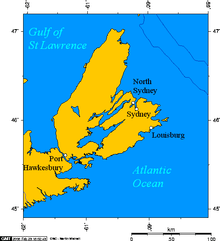
On 23 January 1758, James Wolfe was appointed as a Brigadier General, and sent with Major General Jeffrey Amherst in the fleet of Admiral Boscawen to lay siege to Fortress of Louisbourg in New France (located in present-day Cape Breton Island, Nova Scotia). Louisbourg stood near the mouth of the St Lawrence River and its capture was considered essential to any attack on Canada from the east. An expedition the previous year had failed to seize the town because of a French naval build-up. For 1758 Pitt sent a much larger Royal Navy force to accompany Amherst's troops. Wolfe distinguished himself in preparations for the assault, the initial landing and in the aggressive advance of siege batteries. The French capitulated in June of that year in the Siege of Louisbourg (1758). He then participated in the Expulsion of the Acadians in the Gulf of St. Lawrence Campaign (1758).
The British had initially planned to advance along the St Lawrence and attack Quebec that year, but the onset of winter forced them to postpone to the following year. Similarly a plan to capture New Orleans was rejected,[35] and Wolfe returned home to England. Wolfe's part in the taking of the town brought him to the attention of the British public for the first time. The news of the victory at Louisbourg was tempered by the failure of a British force advancing towards Montreal at the Battle of Carillon and the death of George Howe, a widely respected young general whom Wolfe described as "the best officer in the British Army".[36] He died at almost the same time as the French general
Quebec (1759)
Appointment
As Wolfe had comported himself admirably at Louisbourg, William Pitt the Elder chose him to lead the British assault on Québec City the following year. Although Wolfe was given the local rank of major general while serving in Canada, in Europe he was still only a full colonel. Amherst had been appointed as Commander-in-Chief in North America, and he would lead a separate and larger force that would attack Canada from the south. He insisted on the choice of his friend, the Irish officer Guy Carleton as Quartermaster General or threatened to resign the command.[37] Once this was granted, he began making preparations for his departure. Pitt was determined to once again give operations in North America top priority, as he planned to weaken France's international position by sailing back to India.
Advance up the Saint Lawrence
Despite the large build-up of British forces in North America, the strategy of dividing the army for separate attacks on Canada meant that once Wolfe reached Quebec the French commander Louis-Joseph de Montcalm would have a local superiority of troops having raised large numbers of Canadian militia to defend their homeland.[38] The French had initially expected the British to approach from the east, believing the St Lawrence River was impassable for such a large force, and had prepared to defend Quebec from the south and west. An intercepted copy of British plans gave Montcalm several weeks to improve the fortifications protecting Quebec from an amphibious attack by Wolfe.[39]
Montcalm's goal was to prevent the British from capturing Quebec, thereby maintaining a French foothold in Canada. The French government believed a peace treaty was likely to be agreed the following year and so they directed the emphasis of their own efforts towards victory in Germany and a Planned invasion of Britain hoping thereby to secure the exchange of captured territories. For this plan to be successful Montcalm had only to hold out until the start of winter. Wolfe had a narrow window to capture Quebec during 1759 before the St Lawrence began to freeze, trapping his force.
Wolfe's army was assembled at Louisbourg. He expected to lead 12,000 men, but was greeted by only approximately 400 officers, 7,000 regular troops, and 300 gunners.[40] Wolfe's troops were supported by a fleet of 49 ships and 140 smaller craft led by Admiral Charles Saunders. Eager to begin the campaign, after several delays, he pushed ahead with only part of his force and left orders for further arrivals to be sent on up the St Lawrence after him.[41]
Siege
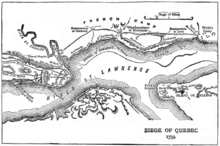
The British army laid siege to the city for three months. During that time, Wolfe issued a written document, known as Wolfe's Manifesto, to the French-Canadian (Québécois) civilians, as part of his strategy of psychological intimidation. In March 1759, prior to arriving at Quebec, Wolfe had written to Amherst: "If, by accident in the river, by the enemy’s resistance, by sickness, or slaughter in the army, or, from any other cause, we find that Quebec is likely to fall into our hands (persevering however to the last moment), I propose to set the town on fire with shells, to destroy the harvest, houses and cattle, both above and below, to send off as many Canadians as possible to Europe and to leave famine and desolation behind me; but we must teach these scoundrels to make war in a more gentleman like manner." This manifesto has widely been regarded as counter-productive as it drove many neutrally-inclined inhabitants to actively resist the British, swelling the size of the militia defending to Quebec to as many as 10,000.
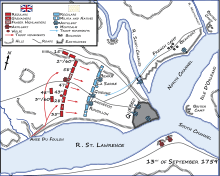
After an extensive yet inconclusive bombardment of the city, Wolfe initiated a failed attack north of Quebec at Beauport, where the French were securely entrenched. As the weeks wore on the chances of British success lessened, and Wolfe grew despondent. Amherst's large force advancing on Montreal had made very slow progress, ruling out the prospect of Wolfe receiving any help from him.
Battle
Wolfe then led 4,400 men in small boats on a very bold and risky amphibious landing at the base of the cliffs west of Quebec along the St. Lawrence River. His army, with two small cannons, scaled the 200-metre cliff from the river below early in the morning of 13 September 1759. They surprised the French under the command of the Marquis de Montcalm, who thought the cliff would be unclimbable, and had set his defences accordingly. Faced with the possibility that the British would haul more cannons up the cliffs and knock down the city's remaining walls, the French fought the British on the Plains of Abraham. They were defeated after fifteen minutes of battle, but when Wolfe began to move forward, he was shot thrice, once in the arm, once in the shoulder, and finally in the chest. Historian Francis Parkman describes the death of Wolfe:
- They asked him [Wolfe] if he would have a surgeon; but he shook his head, and answered that all was over with him. His eyes closed with the torpor of approaching death, and those around sustained his fainting form. Yet they could withhold their gaze from the wild turmoil before them, and the charging ranks of their companions rushing through the line of fire and smoke.
- "See how they run." one of the officers exclaimed, as the French fled in confusion before the levelled bayonets.
- "Who run?" demanded Wolfe, opening his eyes like a man aroused from sleep.
- "The enemy, sir," was the reply; "they give way everywhere."
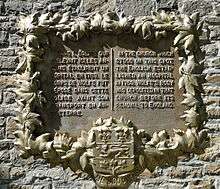
- "Then," said the dying general, "tell Colonel River, to cut off their retreat from the bridge. Now, God be praised, I die contented," he murmured; and, turning on his side, he calmly breathed his last breath.
The Battle of the Plains of Abraham caused the deaths of the top military commander on each side: Montcalm died the next day from his wounds. Wolfe's victory at Quebec enabled an assault on the French at Montreal the following year. With the fall of that city, French rule in North America, outside of Louisiana and the tiny islands of Saint-Pierre and Miquelon, came to an end. James Wolfe's tactics are summarized in E. R. Adair's "Military Reputation of Major-General James Wolfe".[42] Another helpful reference is, "In Wolfe's Clothing", an article written by Ian Brown for The Globe and Mail, a Toronto newspaper, published 31 July 2009.[43]
Wolfe's body was returned to Britain on HMS Royal William and interred in the family vault in St Alfege Church, Greenwich alongside his father (who had died in March 1759). The funeral service took place on 20 November 1759, the same day that Admiral Hawke won the last of the three great victories of the "Wonderful Year" and the "Year of Victories" – Minden, Quebec and Quiberon Bay.
Character
Wolfe was renowned by his troops for being demanding on himself and on them. Although he was prone to illness, Wolfe was an active and restless figure. Amherst reported that Wolfe seemed to be everywhere at once. There was a story that when someone in the British Court branded the young Brigadier mad, King George II retorted, "Mad, is he? Then I hope he will bite some of my other generals."[44] A cultured man, in 1759 during the Seven Years' War, before the Battle of the Plains of Abraham Wolfe is said to have recited Gray's Elegy Written in a Country Churchyard to his officers, adding: "Gentlemen, I would rather have written that poem than take Quebec tomorrow".
After being stung by rejection, in a letter to his mother in 1751 he admitted he would probably never marry and stated that he believed people could easily live without marrying.[44] A biographer once suggested Wolfe may have been a repressed homosexual, although this mode of speculation was typical of the era in which he wrote. On the day before he set sail for Quebec, he contracted to marry Katherine Lowther, daughter of Robert Lowther (1681–1745). After his death a locket miniature of her which was his keepsake was given to Wolfe's mother, who later returned it to its model.[44]
Legacy
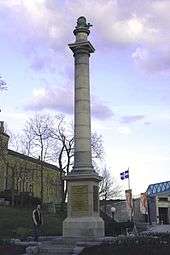
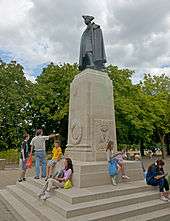
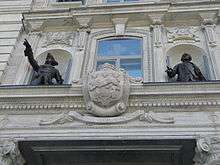
The inscription on the obelisk at Quebec City, erected to commemorate the battle on the Plains of Abraham once read: "Here Died Wolfe Victorious." In order to avoid offending French-Canadians it now simply reads: "Here Died Wolfe."[45] Wolfe's defeat of the French led to the British capture of the New France department of Canada, and his "hero's death" made him a legend in his homeland. The Wolfe legend led to the famous painting The Death of General Wolfe by Benjamin West, the Anglo-American folk ballad "Brave Wolfe"[46] (sometimes known as "Bold Wolfe"), and the opening line of the patriotic Canadian anthem, "The Maple Leaf Forever".
In 1792, scant months after the partition of Quebec into the provinces of Upper Canada and Lower Canada, Lieutenant-Governor (of the former) John Graves Simcoe named the archipelago at the mouth of the St. Lawrence river for the victorious Generals: Wolfe Island, Amherst Island, Howe Island, Carleton Island and Gage Island, for Thomas Gage. The last is now known as Simcoe Island.
In 1832, the first war monument in present-day Canada was erected on the site where Wolfe purportedly fell. The site is marked by a column surmounted by a helmet and sword. An inscription at its base reads, in French and English, "Here died Wolfe – 13 September 1759." It replaces a large stone which had been placed there by British troops to mark the spot.
Wolfe’s Landing National Historic Site of Canada is located in Kennington Cove, on the east coast of Cape Breton Island, Nova Scotia. Contained entirely within the Fortress of Louisbourg National Historic Site of Canada, the site is bounded by a rocky beach to the south, and a rolling landscape of grasses and forest to the north, east and west. It was from this site that, during the Seven Years’ War, British forces launched their successful attack on the French forces at Louisbourg. Wolfe’s Landing was designated a national historic site of Canada in 1929 because: - "here, on 8 June 1758, the men of Brigadier General James Wolfe’s brigade made their successful landing, leading to the capitulation of Louisbourg".[47]
There is a memorial to Wolfe in Westminster Abbey by Joseph Wilton. The 3rd Duke of Richmond, who had served in Wolfe's regiment in 1753, commissioned a bust of Wolfe from Wilton. There is an oil painting "Placing the Canadian Colours on Wolfe's Monument in Westminster Abbey" by Emily Warren in Currie Hall at the Royal Military College of Canada.
A statue of Wolfe overlooks the Royal Naval College in Greenwich, a spot which has become increasingly popular for its panoramic views of London. A statue also graces the green in his native Westerham, Kent, alongside one of that village's other famous resident, Sir Winston Churchill. At Stowe Landscape Gardens in Buckinghamshire there is an obelisk, known as Wolfe's obelisk, built by the family that owned Stowe as Wolfe spent his last night in England at the mansion. Wolfe is buried under the Church of St Alfege, Greenwich, where there are four memorials to him: a replica of his coffin plate in the floor; The Death of Wolfe, a painting completed in 1762 by Edward Peary; a wall tablet; and a stained glass window. In addition the local primary school is named after him. The house in Greenwich where he lived, Macartney House, has an English Heritage blue plaque with his name on, and a nearby road is named General Wolfe Road after him.[48]
In 1761, as a perpetual memorial to Wolfe, George Warde, a friend of Wolfe's from boyhood, instituted the Wolfe Society, which to this day meets annually in Westerham for the Wolfe Dinner to his "Pious and Immortal Memory". Warde paid Benjamin West to paint "The Boyhood of Wolfe" which hangs at Squerres Court. Warde also erected a cenotaph in Squerres Park to mark the place where Wolfe had received his first commission while visiting the Wardes.
In 1979 Crayola crayons introduced a Wolfe Brown colour crayon. It was discontinued the following year.
There are several institutions, localities, thoroughfares, and landforms named in honour of him in Canada. Significant monuments to Wolfe in Canada exist on the Plains of Abraham where he fell, and near Parliament Hill in Ottawa. Ontario Governor John Graves Simcoe named Wolfe Island, an island in Lake Ontario and the Saint Lawrence River off the coast of Kingston (near the Royal Military College of Canada) in Wolfe's honour in 1792. On 13 September 2009, the Wolfe Island Historical Society led celebrations on the occasion of the 250th anniversary of James Wolfe's victory at Quebec. A life-size statue in Wolfe's likeness is to be sculpted.[45]
Mont Royal Park, Calgary is home to a James Wolfe statue since 2009, but it was originally located in Exchange Court in New York City.[49] It was sculpted in 1898 by John Massey Rhind and moved into storage around 1945 to 1950, sold in 1967 and relocated to Centennial Planetarium in Calgary, stored 2000 to 2008 and finally installed again in 2009.[49]
A senior girls house at the Duke of York's Royal Military School is named after Wolfe, where all houses are named after prominent figures of the military. There is a James Wolfe school for children aged 5–11 down the hill from his house in Greenwich, in Chesterfield Walk, which is just east of General Wolfe Road.
His letters home from the age of 13 until his death[50] as well as his copy of Gray's Elegy Written in a Country Churchyard and other items are housed at the Thomas Fisher Rare Book Library in Toronto, Ontario.[51] Other Artifacts and relics owned by Wolfe are held at museums in both Canada and England, although some have mainly legendary association. Wolfe's cloak worn at Louisbourg, Quebec and at the Plains of Abraham is part of the British Royal Collection. In 2008 it was lent to the Maritime Museum of the Atlantic in Halifax for an exhibit on the Siege of Louisbourg and in 2009 was loaned to the Army Museum at the Halifax Citadel where it remains on display.
Point Wolfe is located in Fundy National Park,[52] and the town of Wolfeboro, New Hampshire is named in honour of Wolfe. In Montreal, Rue Wolfe parallels Rue Montcalm and Rue Amherst, while in the Quebec City neighbourhood of Ste-Foy, he has given his name to an Avenue.
Bibliography
- Unknown. "James Wolfe", in The Canadian Encyclopedia. Historica Foundation, 2008
- Baker-Smith, Veronica. Royal Discord: The Family of George II. Athena Press, 2008.
- Black, Jeremy. British Lives: William Pitt. Cambridge University Press, 1992.
- Browning, Reed. The War of the Austrian Succession. Alan Sutton Publishing, 1994.
- Brumwell, Stephen (2007). Paths of Glory: The Life and Death of General James Wolfe, Continuum International Publishing Group, 432 p. ISBN 978-0-7735-3261-8 (preview)
- Bélanger, Claude. "James Wolfe", in L’Encyclopédie de l’histoire du Québec / The Quebec History Encyclopedia, Marianopolis College, 2005
- Carroll, Joy (2004). Wolfe & Montcalm: Their Lives, their Times, and the Fate of a Continent, Richmond Hill: Firefly Books, 302 p. ISBN 1-55297-905-9 (preview)
- Casgrain, Henri-Raymond (1905). Wolfe and Montcalm, Toronto: Morang & Co., 296 p.
- Chartrand, René (2000). Louisbourg 1758: Wolfe's First Siege, Oxford: Osprey Military, 96 p. (preview)
- Corbett, Julian Stafford England in the Seven Years' Waw, Volume I. London, 1907,
- Corbett, Julian Stafford England in the Seven Years' Waw: Volume II. London, 1907.
- McNairn, Alan (1997). Behold the Hero: General Wolfe and the Arts in the Eighteenth Century, Montreal: McGill-Queen's Press, 306 p. ISBN 0-7735-1539-9 (preview)
- Johnston, Andrew. Endgame 1758: The promise, the glory and the Louisbourg's last decade. University of Nebraska, 2007.
- Nelson, Paul David. General Sir Guy Carleton, Lord Dorchester: Soldier-Statesman of Early British Canada. Associated University Presses, 2000.
- Parkman, Francis (1884). Montcalm and Wolfe, Boston: Little, Brown and Company, (online: volume 1, volume 2)
- Pocock, Tom. Battle for Empire: The very first world war 1756–63. Michael O'Mara Books, 1998.
- Reilly, Robin (1960). Wolfe of Quebec, London: White Lion Publishers, 365 p. (online)
- Reid, Stuart (2000). Wolfe: The Career of General James Wolfe from Culloden to Quebec, Rockville Centre (N.Y.): Sarpedon, 224 p.
- Snow, Dan. Death or Victory: The Battle of Quebec and the Birth of Empire. Harperpress, 2009.
- Stacey, C. P. "Wolfe, James", in Dictionary of Canadian Biography Online, University of Toronto and Université Laval, 2000
- Stanhope, Philip Henry. History of England. Volume IV. London, 1858.
- Trench, Charles Chevenix. George III. The History Book Club, 1973.
- Warner, Oliver (1972). With Wolfe to Quebec: The Path to Glory, Toronto: Collins, 224 p.
- Williams, Guy R. London in the Country - The Growth of Suburbia. Hamish Hamilton, 1975.
- Wilson, Kathleen (editor). A New Imperial History. Culture, Identity and Modernity in Britain and the Empire, 1660–1840. Cambridge University Press.
- Willson, Beckles. "The Life and Letters of James Wolfe" 1909 (online)
- Wolfe, James: Collection of letters at Thomas Fisher Rare Book Library.[53]
- Wright, Robert (1864). The Life of Major-General James Wolfe, London: Chapman and Hall, 626 p. (online)
References
- ↑ "General Wolfe : Salmon, Edward, 1865- : Free Download & Streaming : Internet Archive".
- ↑ Wilson p.244
- ↑ "The Weald - People history and genealogy".
- ↑ "Biography of General James Wolfe".
- ↑ Browning p.59-61
- ↑ Brumwell p.18-19
- ↑ Brumwell p.24-25
- ↑ Brumwell p.25
- ↑ Browning p.134-35
- ↑ Trench p.217-18
- ↑ Brumwell p.26-27
- ↑ Brumwell p.29-31
- ↑ Browning p.139-40
- ↑ Pocock p.115
- ↑ Brumwell p.35-36
- ↑ Brumwell p.36-37
- ↑ Browning p.240-44
- ↑ Brumwell p.42-43
- ↑ Baker-Smith p.131-33
- ↑ History and chronology of James Wolfe in Great Britain
- ↑ Baker-Smith p.139
- ↑ Browning p.259-60
- ↑ Brumwell p.57-58
- ↑ Brumwell p.58-63
- ↑ Brumwell p.92-93
- ↑ Brumwell p.93-97
- ↑ Soldiers: A History of Men in Battle. John Keegan, Richard Holmes, John Gau; 1986; p.55
- ↑ Brumwell p. 111–115
- ↑ "Historical Biographies, Nova Scotia: James Wolfe (1727-1759).".
- ↑ Brumwell p. 106
- ↑ Corbett. Volume I p. 202
- ↑ Black p.171
- ↑ Johnston p. 138
- ↑ Stanhope p. 110
- ↑ Brown p. 165
- ↑ Pockock p. 95
- ↑ Nelson p.22
- ↑ Dull p.144-45
- ↑ Dull p.142-46
- ↑ Reid 2003, p. 25.
- ↑ Snow p.21-30
- ↑ Military Reputation of Major-General James Wolfe
- ↑ "In Wolfe's clothing".
- 1 2 3 Parkman, Francis: "Montcalm and Wolfe"
- 1 2 nurun.com. "Wolfe celebrations set for 2009".
- ↑ http://www.dpnews.com/midimelodies/Brave%20Wolfe.MID
- ↑ "HistoricPlaces.ca - HistoricPlaces.ca".
- ↑ Williams, p. 85
- 1 2 "General Wolfe - Calgary, Alberta - Statues of Historic Figures on Waymarking.com".
- ↑ "U of T Libraries Acquire General James Wolfe's Historic Letters. (n.d.)". fisher.library.utoronto.ca.
- ↑ Brown, Ian. "Inside old-school books, every scribble tells a story". The Globe and Mail.
- ↑ "Fundy National Park".
- ↑ "Archive of General Wolfe's personal letters is coming to Canada".
Further reading
- Bell, Andrew (1859). British-Canadian Centennium, 1759–1859: General James Wolfe, His Life and Death: A Lecture Delivered in the Mechanics' Institute Hall, Montreal, on Tuesday, September 13, 1859, being the Anniversary Day of the Battle of Quebec, fought a Century before in which Britain lost a Hero and Won a Province. Quebec: J. Lovell. p. 52.
- Bradley, Arthur Granville (1895). Wolfe. London: Macmillan and Co., Limited. p. 214.
- Burpee, Lawrence J. (1926). "James Wolfe". The Oxford Encyclopaedia of Canadian History. London & Toronto: Oxford University Press: 690–691.
- Carroll, Joy (2006). Wolfe et Montcalm : la véritable histoire de deux chefs ennemis (in French). trans. Suzanne Anfossi. Montréal: Éditions de l'Homme. p. 362. ISBN 2-7619-2192-5.
- Casgrain, Philippe-Baby (1904). La maison de Borgia, premier poste de Wolfe à la bataille des Plaines d'Abraham : où était-elle située? (in French). Ottawa: Chez Hope & Fils. pp. 45–62.
- Clarke, John Mason (1911). Results of Excavations at the Site of the French "Custom House" or "General Wolfe's House" on Peninsula Point in Gaspe Bay. Montréal: C.A. Marchand. p. 23.
- Doughty, Arthur George (1901). The Siege of Quebec and the battle of the Plains of Abraham. 1–6. Quebec: Dussault & Proulx.
- Grove of Richmond (1759). A letter to a Right Honourable Patriot upon the glorious success at Quebec: in which is drawn a parallel between a good and bad general, a scene exhibited wherein are introduced (besides others) three of the greatest names in Britain, and a particular account of the manner of General Wolfe's death, with a postscript which enumerates the other conquests mentioned in the London address. London: J. Burd. p. 58.
- Hibbert, Christopher (1959). Wolfe at Quebec. Cleveland: World Publishing, Green and Co. p. 194.
- Le Jeune, Louis (1931). "James Wolfe". Dictionnaire Général de biographie, histoire, littérature, agriculture, commerce, industrie et des arts, sciences, moeurs, coutumes, institutions politiques et religieuses du Canada (in French). Ottawa: Université d'Ottawa. 2: 818–821.
- Mauduit, Israel (1765). An Apology for the Life and Actions of General Wolfe: Against the Misrepresentations in a Pamphlet, called, A Counter Address to the Public, with some other Remarks on that Performance. London. p. 69.
- Pringle, John (Bt) (1760). Life of General James Wolfe, the conqueror of Canada, or, The elogium of that renowned hero : attempted according to the rules of eloquence with a monumental inscription Latin and English to perpetuate his memory. London. p. 36.
- Sabine, Lorenzo (1859). An Address Before the New England Historic-Genealogical Society, in the Hall of the House of Representatives of Massachusetts, Tuesday, Sept. 13th, 1859: The hundredth anniversary of the death of Major General James Wolfe... Boston: A. Williams & Co. p. 100.
- Salmon, Edward (1909). General Wolfe. Toronto: Cassell & Co. p. 248.
- Stacey, Charles P. (2000). "Wolfe, James". Dictionnaire biographique du Canada en ligne (in French). University of Toronto and Université Laval.
- Stacey, Charles P. (2000). "Wolfe, James". Dictionary of Canadian Biography Online. University of Toronto and Université Laval. Retrieved 9 September 2009.
- Sutherland, John Campbell (1926). General Wolfe. Toronto: Ryerson Press. p. 31.
- W. Stewart, (Ed.) Wallace (1948). "James Wolfe". The Encyclopedia of Canada. Toronto: University Associates of Canada. VI: 315–316.
- Waugh, William Templeton (1928). James Wolfe, Man and Soldier. Montreal: Louis Carrier & Co. p. 333.
- Webster, John Clarence (1925). A Study of the Portraiture of James Wolfe. Ottawa: Royal Society of Canada. pp. 47–65.
- Whitton, Frederick Ernest (1929). Wolfe and North America. London: Ernest benn Limited. p. 420.
- Willson, Beckles (1909). The Life and Letters of James Wolfe. London: William Heinemann. p. 522.
- Wolfe-Aylward, Annie Elizabeth Chenells (1926). The Pictorial life of Wolfe. Plymouth: Brendon and son, Ltd. p. 213.
- Wolfe: Portraiture and Genealogy. London: Permanent Advisory Committee of Quebec House. 1959. p. 111.
- "Wolfiana". Archives & Research Library, New Brunswick Museum. New Brunswick Museum. 2003. Retrieved 10 September 2009.
- Wood, William (1915). The Winning of Canada: A Chronicle of Wolfe. Toronto: Glasgow, Brook & Co. p. 152.
External links
| Wikimedia Commons has media related to James Wolfe. |
| Wikisource has original works written by or about: James Wolfe |
- Works by or about James Wolfe at Internet Archive
- Works by James Wolfe at LibriVox (public domain audiobooks)

- Unknown. "History and Chronology of James Wolfe", in World History Database
- New Brunswick Museum. "A National Treasure in New Brunswick: James Barry's Death of General Wolfe", in New Brunswick Museum (Web site), 2003
- NBC. Plains of Abraham Web site, Government of Canada. (National Battlefields Commission)
- NBC. 1759: From the Warpath to the Plains of Abraham, Virtual Museum Canada, The National Battlefields Commission, 2005
| Military offices | ||
|---|---|---|
| New regiment | Colonel of the 67th Regiment of Foot 1758–1759 |
Succeeded by Lord Frederick Cavendish |

